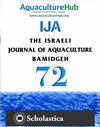Hepatopancreatic transcriptome response of Penaeus vannamei to dietary ulvan
IF 0.5
4区 农林科学
Q4 FISHERIES
引用次数: 0
Abstract
The study aimed to determine the effect of feeding dietary ulvan on some genes and pathways of Penaeus vannamei juveniles. Feeding a diet containing ulvan at 1.0 g·kg-1 resulted in differentially expressed genes (DEGs) between the treatments and the control group. Ulvan resulted in 53 DEGs with 26 up and 27-down-regulated DEGs. The DEGs were immune-related, while several affected the energy and substrate metabolic pathways. Specific genes upregulated were Glycerol-3-phosphate acyltransferase (GPAT) of the glycerolipid synthesis, centrosomal protein 120 involved in cell cycling and other activities, RNA helicase, an enzyme involved in opening up DNA molecules, ATP-binding cassette, TATA-binding protein, taurine transporter, transcriptional enhancer factor (TEF), C-type lectin among others. Down-regulated genes included gamma-crystallin, which acts as molecular chaperones; catenin alpha, which is involved in adhesion complex; dystrophin, which is involved in scaffolding for several signaling molecules; and maintenance muscle integrity, among others. Top DEGs that affected significantly important pathways include TEAD (transcriptional enhancer factor domain), GSK3B (glycogen synthase Kinase 3 beta), SLC6A1 (i.e., solute carrier Family 6 Member 1), and ADCY2, which affected signal transduction, environmental adaptation as well as the endocrine, immune, nervous, and digestive systems. In conclusion, dietary ulvan resulted in the up-regulation of immune-related DEGs, which could probably be used to adapt to unfavorable conditions and also affected some energy and substrate metabolic pathways that could potentially be used to direct the overall metabolism.凡纳滨对虾肝胰腺转录组对饲粮ulvan的响应
本研究旨在探讨饲粮中添加乌尔万对凡纳滨对虾幼鱼部分基因和途径的影响。饲粮中添加1.0 g·kg-1的ulvan导致处理组与对照组之间基因差异表达(DEGs)。Ulvan产生53个基因,其中26个基因上调,27个基因下调。deg与免疫相关,而一些影响能量和底物代谢途径。特异性上调的基因包括甘油脂合成的甘油-3-磷酸酰基转移酶(GPAT)、参与细胞循环等活动的中心体蛋白120、参与打开DNA分子的RNA解旋酶、atp结合盒、tata结合蛋白、牛磺酸转运蛋白、转录增强因子(TEF)、c型凝集素等。下调的基因包括作为分子伴侣的γ -晶体蛋白;连环蛋白,它参与了粘附复合体;肌营养不良蛋白,它参与了几个信号分子的支架;保持肌肉的完整性,等等。影响重要通路的顶级deg包括TEAD(转录增强因子结构域)、GSK3B(糖原合成酶激酶3 β)、SLC6A1(即溶质载体家族6成员1)和ADCY2,它们影响信号转导、环境适应以及内分泌、免疫、神经和消化系统。综上所述,饲粮ulvan导致免疫相关deg上调,这可能用于适应不利条件,也可能影响一些能量和底物代谢途径,这些途径可能用于指导整体代谢。
本文章由计算机程序翻译,如有差异,请以英文原文为准。
求助全文
约1分钟内获得全文
求助全文
来源期刊
CiteScore
0.90
自引率
16.70%
发文量
49
审稿时长
3 months
期刊介绍:
Information not localized

 求助内容:
求助内容: 应助结果提醒方式:
应助结果提醒方式:


